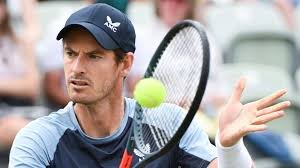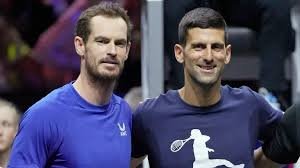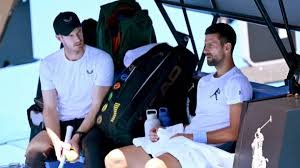
Introduction: The Rise of Murray and Djokovic
Andy Murray and Novak Djokovic are two of the most prominent figures in modern tennis, each carving out illustrious careers that have significantly impacted the sport. Murray, hailing from Scotland, gained prominence as a formidable competitor on the ATP Tour, achieving his first Grand Slam title at the 2012 US Open. His career has been characterized by a relentless work ethic and exceptional shot-making, resulting in multiple Grand Slam victories, including two Wimbledon titles and an Olympic gold medal. Known for his tactical intelligence and defensive prowess, Murray’s journey has inspired many aspiring athletes around the world.
On the other hand, Novak Djokovic, a Serbian tennis powerhouse, has established himself as one of the greatest players in the history of the sport. With a record number of weeks at No. 1 in the ATP rankings and an impressive collection of Grand Slam titles, Djokovic’s career is marked by his physical prowess, mental fortitude, and innovative playing style. His 2023 season, which featured a dominant performance at Wimbledon and continued success in various tournaments, further solidified his place as a tennis legend.
The rivalry between Murray and Djokovic has been one of the most compelling narratives in tennis. Their matches, often characterized by high-stakes tension and remarkable athleticism, have provided fans with unforgettable moments and have played a crucial role in shaping the ATP landscape. Both players have pushed each other to new heights, showcasing the essence of competitive sportsmanship. However, their relationship extends beyond the court, as practice sessions between the two have become a talking point, often reflecting larger issues facing professional tennis today.
Murray’s recent heartfelt complaint after practicing with Djokovic raises pertinent questions about competitiveness and sportsmanship in tennis. The nature of their interactions, both during matches and practice, demonstrates the complexities and nuances that exist within the current state of the sport. This discourse provides a deeper understanding of their relationship and the implications it has for the future of tennis.
The Training Session: A Behind-the-Scenes Look
The recent practice session between Andy Murray and Novak Djokovic provided a unique insight into the rigorous preparation that elite tennis players undertake. The atmosphere was charged with intensity, reflecting the competitive spirit both players are known for. The practice took place on a well-maintained hard court, with the sun shining down, creating optimal conditions for a high-level training session.
As the session began, both players quickly engaged in a warm-up, which included light jogging and stretching exercises. This initial phase was crucial, considering the physical demands of their respective playing styles. After warming up, they transitioned into a series of drills designed to sharpen their skills. Djokovic, known for his incredible baseline game, executed precise groundstrokes while Murray showcased his agility and quick reflexes, often responding with powerful returns.
Particular attention was given to serve-and-volley drills, assessing both players’ capabilities at the net. The drills highlighted their strategic thinking, as they constantly adapted to one another’s strengths and weaknesses. Murray’s tactical approach involved placing his shots to challenge Djokovic’s defensive skills. Meanwhile, Djokovic employed his typical relentless pursuit of perfection, adjusting his footwork and shot accuracy meticulously.
Throughout the session, the intensity increased, reflecting their desire to push one another to new heights. Both players demonstrated commendable sportsmanship, often pausing to discuss strategies and offer constructive feedback. The camaraderie was palpable, underscoring their respect for each other’s talents.
Overall, this practice session illustrated not only the physical demands placed on professional athletes but also the mental fortitude required to excel at such a high level. The mutual drive for excellence displayed by Andy Murray and Novak Djokovic serves as a reminder of the dedication inherent in the world of competitive tennis.
Murray’s Complaint: Context and Implications
Andy Murray, a prominent figure in the world of tennis, recently expressed his frustrations after a practice session with Novak Djokovic, a fellow elite competitor and multiple Grand Slam champion. Murray’s comments were not merely offhand remarks; they reflected a deeper concern regarding the challenges faced by professional athletes as they prepare for high-stakes competitions. The tone of Murray’s remarks was earnest and candid, emphasizing the emotional and physical toll that rigorous training can impose on players at the top of their game.
During the practice, Murray highlighted the discrepancies in preparation methods and the increasing intensity of training sessions that elite athletes endure. His sentiments resonate with a broader discourse among players who grapple with the relentless demands of modern tennis. These demands can lead to increased pressures, impacting not only performance but also the overall well-being of the athletes involved. Murray’s reflections raise critical points about the expectations placed on professionals, especially when competing against titans like Djokovic, whose own preparation routines are renowned for their meticulousness and innovation. This stress to consistently perform at an optimal level is compounded by the physical and mental fatigue that comes from facing such formidable opponents.
In competitive sports, especially in singles events like tennis, athletes often have to navigate the dichotomy between personal health and performance pressures. Murray’s complaint indicates a shift towards a more open dialogue about mental wellness and the importance of tailored training regimens that consider not only the physical but also the psychological aspects of preparation. His feelings, therefore, are significant as they contribute to the ongoing conversation around athlete well-being in elite sports.
Media Reactions: Covering Murray’s Comments
Following Andy Murray’s heartfelt complaint about his practice session with Novak Djokovic, various media outlets and tennis commentators have provided insightful reactions and analyses. Many journalists highlighted Murray’s expression of frustration, particularly focusing on the competitive nature of their sessions and the stark differences in their current playing styles.
Notably, sports analyst Rebecca Thompson noted, “Murray’s comments speak volumes about the challenges he faces against players like Djokovic, who consistently raise the bar in professional tennis.” This observation underscores the growing discussion around the evolving dynamics of competition in the sport, especially among seasoned athletes. This shift is crucial as it often influences how fans perceive moments of vulnerability in professional tennis.
In addition to journalists, former players also weighed in, with former world number one John McEnroe stating, “Every player has their threshold; Murray’s call for competitive sportsmanship reflects the pressures many face at the elite level.” His analysis drew attention to the psychological aspects of tennis, suggesting that players not only compete physically but also mentally in practice scenarios.
Moreover, the media has acknowledged that Murray’s remarks have opened a dialogue about how athletes manage their competitiveness while maintaining sportsmanship. Several opinion articles emphasized that while fierce competition is intrinsic to tennis, mutual respect among players fosters a healthier environment. This nuance in sportsmanship highlights the delicate balance athletes must strike between rivalry and camaraderie.
The engagement surrounding Murray’s comment illustrates not just the burden of competition faced by athletes, but also the broader implications for the sport itself. As conversations continue, the tennis community appears eager to explore how competitiveness and respect can coexist in practice settings and match play.
Djokovic’s Perspective: A Champion’s Response
Novak Djokovic, a prominent figure in the tennis world, is not only renowned for his extraordinary skills on the court but also for his sportsmanship and character off it. In the wake of Andy Murray’s public complaint following their practice session, Djokovic offered insights that reflected both his perspective as a champion and his attitudes towards competitive training. Djokovic acknowledged the intensity required in preparation for matches, emphasizing that practice sessions often serve as critical platforms for honing skills and strategies that translate into performance during tournaments.
In Djokovic’s response, he highlighted the importance of mutual respect between players during practice sessions. He expressed that such encounters are not merely casual workouts but rather opportunities to push each other to improve. This philosophy aligns with his belief that competition amongst elite athletes is a shared responsibility. To Djokovic, training sessions with esteemed colleagues like Murray represent valuable learning experiences that can benefit both players. His inclination towards constructive dialogue further underpins his approach to rivalry, suggesting that competitive spirit can coexist with camaraderie.
<pmoreover, a=”” allowing=”” among=”” an=”” and=”” are=”” atmosphere=”” by=”” collaboration,=”” comments=”” commitment=”” communication=”” competitors,=”” could=”” cultivate=”” dimensions=”” djokovic=”” djokovic’s=”” doing=”” each=”” elevate=”” emotional=”” environment=”” epitomized=”” equally=”” essential,=”” even=”” experiences=”” fierce=”” for=”” frustration.=”” growth=”” he=”” his=”” implied=”” important.=”” is=”” level=”” maintaining=”” needs=”” noting=”” of=”” open=”” p=”” play=”” player’s=”” positive=”” preferences.=”” psychological=”” rather=”” regarding=”” remarked=”” shared=”” so,=”” sport.
Through his reflections, Djokovic reinforced his status not just as a remarkable athlete, but as an individual dedicated to fostering a supportive and respectful tennis community. His ability to navigate complaints and grievances with understanding showcases a balanced approach that is commendable in the world of competitive sports.
Mental Health in Sports: The Pressure on Athletes
The mental health challenges faced by athletes are often overshadowed by their physical prowess and public personas. In the highly competitive realm of professional sports, the pressure to perform can be overwhelming, influencing not only their success on the court but also their overall well-being. Athletes like Andy Murray and Novak Djokovic exemplify this struggle, particularly during intense practice sessions where expectations run high. The constant scrutiny from media and fans adds an additional layer to the psychological burden these athletes carry.
Recent discussions surrounding mental health in sports have highlighted the necessity of addressing these issues within the athletic community. Murray’s candid observations about his experiences with pressure during practice sessions serve as a poignant example of the emotional labor required in elite sports. It is crucial to foster an environment where athletes feel comfortable sharing their mental health concerns without fearing backlash or stigma. Open dialogue among sports professionals can lead to innovative support systems that contribute positively to athlete welfare.
The importance of mental health awareness in sports cannot be understated. Initiatives encouraging athletes to discuss their experiences are vital for creating a culture that prioritizes mental well-being, much like physical conditioning. Governing bodies and organizations within the sports world are beginning to take steps towards integrating mental health resources into athlete training programs. This highlights a growing recognition that mental resilience is as critical as physical stamina for achieving success. Ultimately, by promoting mental health awareness in sports, we can help dismantle the barriers that prevent athletes from seeking the support they need during their careers.
Tennis Evolution: Comparing Eras and Styles
The sport of tennis has undergone significant transformation since the time Andy Murray and Novak Djokovic entered the professional circuit. The evolution of tennis can be delineated through changes in training methodologies, player mentalities, and competitive dynamics that characterize different eras. Each generation of players experiences unique challenges and opportunities, shaping their approach to the game.
Training methodologies have advanced remarkably, incorporating scientific insights and technological innovations. Modern players benefit from sophisticated analytics that allow for a deeper understanding of their performance metrics, biomechanics, and opponent strategies. In contrast, during the early phases of Murray’s and Djokovic’s careers, training was primarily centered around physical conditioning and fundamental skills. As a result, today’s players can engage in more focused practices, enabling them to enhance specific aspects of their game. This shift not only leads to improved individual performance but also cultivates a higher overall standard within the sport.
The mindset of players has also seen a marked evolution. Current tennis athletes exhibit a fierce competitive spirit, often resulting from the cumulative pressure of a well-documented ranking system and the intense scrutiny from fans and media. This environment fosters a sense of continuous improvement and resilience, compelling veterans like Murray and Djokovic to adapt to new styles of play and strategies that younger competitors bring to the court. Moreover, the mental fortitude required to manage the evolving stakes has become more pronounced, as players learn to navigate the psychological demands of competing against both peers and the rising tide of talent.
Competitive dynamics have shifted as well, with an influx of emerging talents bringing a diverse range of playing styles into the mix. This factor contributes to a complex tapestry of rivalry challenges for established players, who must continuously recalibrate their game. Consequently, as tennis continues its evolution, both Murray and Djokovic exemplify the necessity of adaptability in maintaining peak performance amidst a rapidly changing landscape.
Fan Reactions: What Do the Fans Think?
The online tennis community has been buzzing with reactions following Andy Murray’s heartfelt complaint regarding his practice session with Novak Djokovic. As the conversation spread across social media platforms and forums, tennis fans shared a myriad of opinions, reflecting both their admiration for the players and their understanding of the pressures they face. Many fans expressed empathy towards Murray, recognizing the weight of expectations placed on professional athletes, especially those attempting to return to peak performance after injuries.
One prominent theme among fan reactions was the relatable nature of Murray’s comments. Numerous individuals articulated how they see Murray’s experience mirroring their own challenges in amateur sports, where performance anxiety and self-doubt can often surface. This connection allowed fans to sympathize with Murray’s plight, as they discussed their shared experiences of facing intense pressure, whether in casual games or competitive leagues. The honesty of his statement resonated deeply, opening up a dialogue about mental health and the importance of discussing these challenges openly within sports.
On various social media threads, fans articulated their appreciation for both players’ dedication to the sport. Supporters noted how Djokovic’s training intensity is an admirable quality, but they also acknowledged that such competitiveness can create a challenging environment for others. Some fans even pointed out that while high expectations are a hallmark of elite sports, they can be burdensome, leading to stress and burnout.
This conversation reflects a broader discourse about the mental and emotional ramifications that top players like Murray and Djokovic endure, making it clear that fan reactions are not only about the players’ abilities but also about the human experience behind the sport. As discussions continue to unfold, it is clear that the community values empathy and understanding in grappling with the realities that accompany life as a professional athlete.
Conclusion: Reflecting on Murray and Djokovic’s Legacy
The recent exchange between Andy Murray and Novak Djokovic during a practice session has stirred considerable discussion within the tennis community. Murray’s heartfelt complaint about the growing physical demands placed on players highlights a significant concern that resonates beyond individual grievances. It underscores the increasing intensity and competitiveness prevalent in professional sports, where athletes continually push their limits in pursuit of excellence.
This incident acts as a microcosm of broader themes in tennis, specifically the mental and physical toll that elite-level competition exacts on athletes. Murray’s candid expression of his feelings not only reveals his personal struggle but also brings to light the pressures faced by many players, particularly as the sport continues to evolve. The rivalry between Murray and Djokovic has always been marked by mutual respect, yet it also brings forth tensions that encapsulate the challenges inherent in the highest echelons of their profession.
As we contemplate their legacies, it is evident that both players have significantly shaped the sport. Djokovic’s dominant playing style and consistent performances have set benchmarks in tennis, while Murray’s resilience and commitment have inspired many. The implications of Murray’s complaint extend beyond the individuals involved; they prompt an evaluation of the standards that govern professional sports today. The future may hold further developments regarding their careers as they navigate these complexities, but its outcomes will likely impact not only their trajectories but also the sport as a whole.
In conclusion, the dialogue surrounding Murray’s heartfelt remarks serves as a vital reminder of the intricate balance between competition and well-being in professional sports. It invites reflection on the evolving landscape of athletics and what it means for current and future generations of players. The legacy of both Andy Murray and Novak Djokovic will undoubtedly continue to influence tennis, holding lessons for athletes, organizers, and fans alike.






